
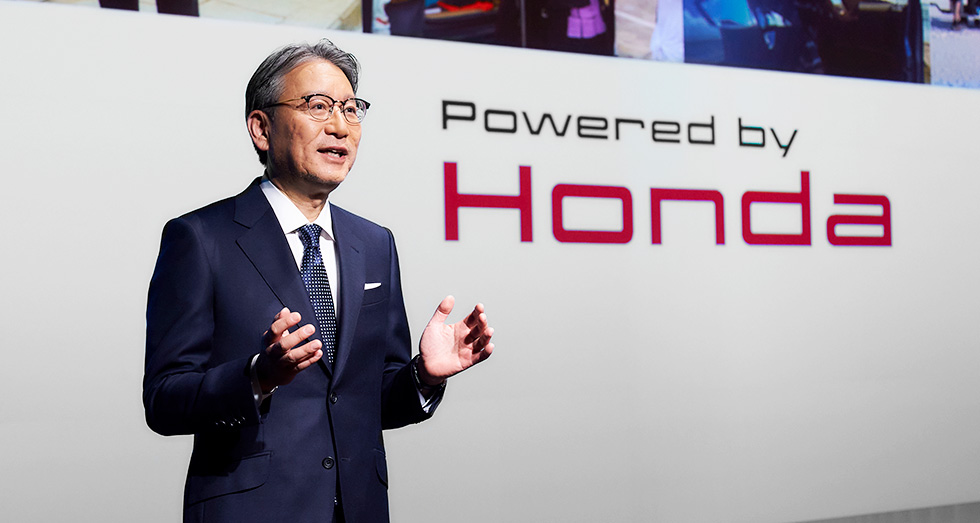
TOKYO, Japan, April 23, 2021 -- Honda Motor Co., Ltd. President and Representative Director Toshihiro Mibe held an inaugural press conference at 3:00 pm today (Japan time).
Following is a summary of his formal remarks:
<Powered by Honda>
Honda is a mobility company that offers a wide range of products which, in total, makes Honda the world's largest power unit manufacturer. Since its founding and through our wide array of power units, Honda has always been contributing to the advancement of mobility and people’s daily lives by providing the “power” which enables people to take action.
By becoming the “power” that supports people who are trying to do things through their own initiative, including those who are trying to make changes to the society they live in and others who strive to enhance the quality of people’s daily lives, we will help people expand their own potential.
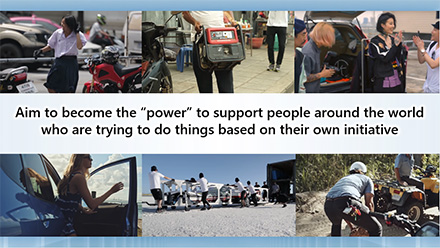

Toshihiro Mibe/President and Representative Director
<What Honda wants to achieve/direction of our initiatives>
Honda will work comprehensively to address challenges in the areas of the environment and safety. At the same time, for the future, Honda will strive to lead advancements which will be made in the areas of mobility, the power unit, energy and robotics.
Moreover, to have a firm footing in working toward our environmental and safety goals, we will remain committed to ensure the attainment of our goal to “solidify our existing businesses”.
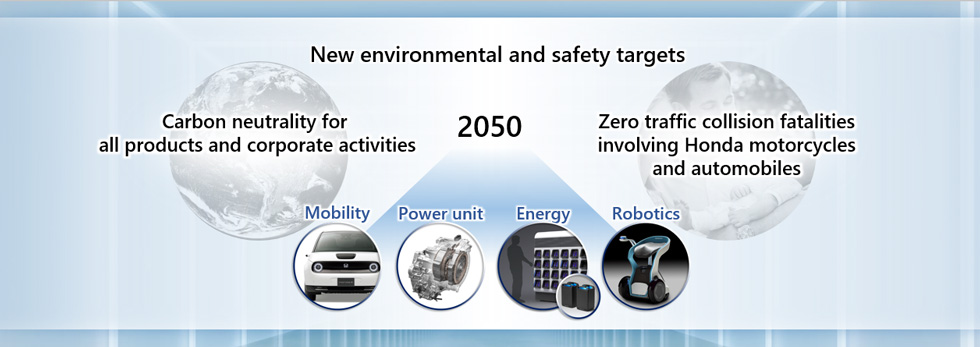
1. Environmental Initiatives
1-1. Three initiatives in pursuit of “zero environmental impact”
Honda will strive to realize carbon neutrality for all products and corporate activities Honda is involved in by 2050. Striving for “zero environmental impact” of not only our products but the entire product lifecycle including our corporate activities, Honda will focus on the following areas as the “three-pillars” of our initiatives:
- Carbon neutrality
- Clean energy
- Resource circulation
- In addition to the electrification of our motorcycle and automobile products, we will expand the range of electrified products with our Honda Mobile Power Pack swappable battery and expand utilization of renewable energy by enabling infrastructure-linked smart power operations.
- For the further expansion of the use of renewable energy, we will be proactive in promoting the utilization of hydrogen. We will strive to realize a “multi-pathway of energy,” which is a concept of utilizing a wide variety of energy sources including carbon-neutral fuels, which will be effective in all areas, including where electrification is difficult, such as with aircraft.
- Including more effective ways to reuse and recycle batteries, Honda is pursuing research on material recycling and will take on the challenge of developing products made from 100% sustainable materials.
- We also will continue to work on the concept of “Honda eMaaS” through which Honda will contribute to the “freedom of mobility” and “expanded use of renewable energy” by connecting electrified mobility products and energy service. Honda eMaaS will be steadily pursued while focusing on the following three core areas:
- Expansion of the utilization of Mobile Power Packs
- Utilization of large-capacity batteries for electrified vehicles
- Application and implementation of fuel cell systems.
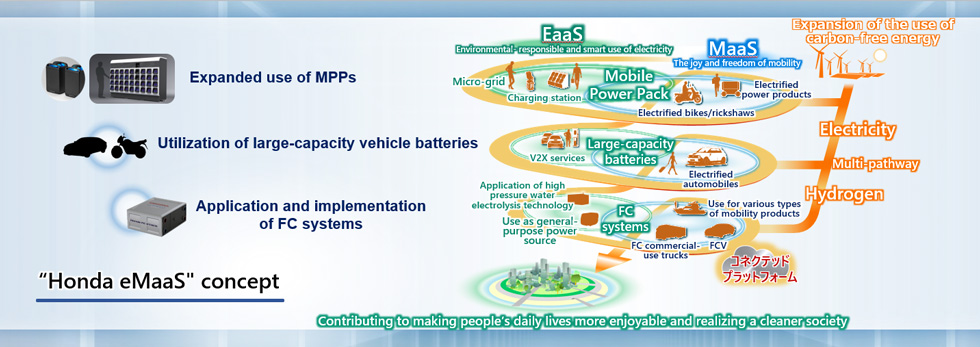
1-2. Electrification of automobile products
In order to achieve our carbon-free goal on a “tank-to-wheel” basis, as the responsibility of an automaker, Honda will strive to increase the ratio of battery-electric vehicles (EVs) and fuel cell electric vehicles (FCVs) within overall unit sales in all major markets of electrification combined to 40% by 2030, to 80% by 2035, and then to 100% globally by 2040. These are challenging targets, and to attain them, we must put forth a collective effort of our entire value chain. However, we decided to set high goals so that all of us share the vision of what we are trying to accomplish and take on challenges toward the realization of our goals.
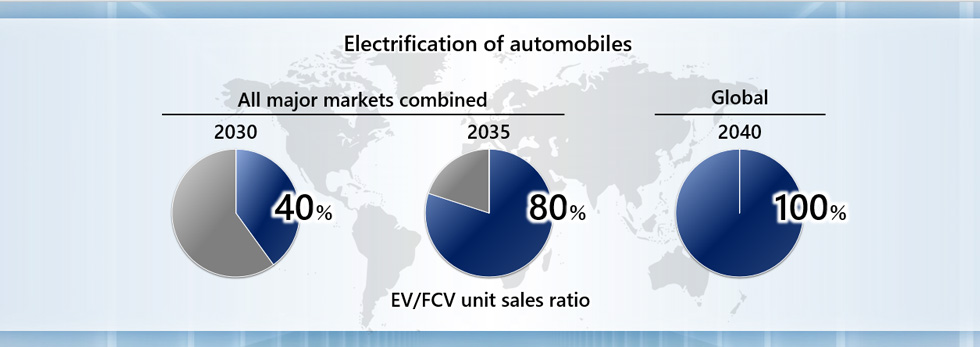
■North America
- In North America, we will strive for an EV/FCV unit sales ratio of 40% by 2030, 80% by 2035 and 100% by 2040. Leveraging the alliance with GM as one of our strategic pillars, we will pursue electrification in North America efficiently while taking advantage of the respective strengths of both companies
- Honda and GM are jointly developing two large-sized EV models using GM’s Ultium batteries, and we are planning to introduce these models to the North American market as model year 2024 vehicles, one from Honda brand and the other from the Acura brand.
- Starting from the second half of the 2020s, Honda will launch a series of new EV models which adopt e:Architecture, a completely new EV platform led by Honda. These EV models will first be introduced to the North American market, and then to other regions of the world.
■China
- In China, we will strive for an EV/FCV unit sales ratio of 40% by 2030, 80% by 2035 and 100% by 2040.
- In China, we have been introducing EV models while utilizing local resources, and we will further accelerate this approach from here forward. We will introduce 10 Honda-brand EV models within five years. As the first of the 10 models, the mass-production model based on the Honda SUV e:prototype is scheduled to go on sale in spring 2022.
- We will further pursue the utilization of local resources, which includes strengthening our collaboration with CATL for the supply of batteries, which are core components for electrified vehicles.
■Japan
- In Japan, we will strive for an EV/FCV unit sales ratio of 20% by 2030, 80% by 2035 and 100% by 2040. Also, including hybrid-electric vehicles, we will strive to electrify 100% of our automobile unit sales in Japan by 2030.
- Including the first introduction of an EV model in the K-car segment in 2024, we will continue making progress in the electrification of our mini-vehicles with both hybrid and EV models.
- For the procurement of batteries, we will strive to realize a “local production and local procurement” approach in Japan, which also will contribute to the growth of domestic industries in Japan.
- In the area of mobility services (MaaS), we are aiming to introduce the Cruise Origin, an electric self-driving vehicle Honda is currently developing jointly with GM and Cruise, in the Japanese MaaS market in the mid-2020s. With this aim, we will be starting development for testing in Japan from this year.
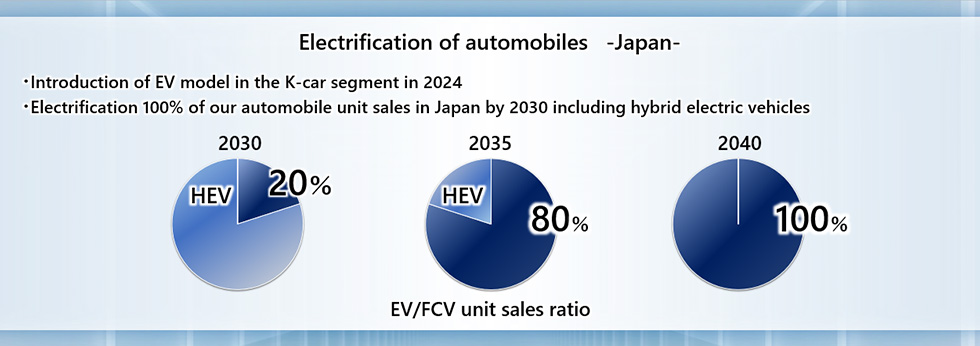
In order to secure the high competitiveness of our EVs of the future, Honda is conducting independent research on all-solid-state batteries as the next generation batteries which will realize high capacity and low cost. We will undertake the verification of production technology using a demonstration line, starting this fiscal year. We will begin accelerating this research with an aim to make all-solid-state batteries available for our new models to be introduced in the second half of the 2020s.
Honda has a track record of offering customers “creative movers,” products in Japan such as Odyssey and StepWGN that help create better daily lives for people. This stance will not change in the world of EVs. By combining digital technologies with Honda’s existing strengths, such as unique creativity and original designs, we will continue to add unique value only Honda can offer to our EVs.
1-3. Electrification of motorcycle products
Honda will strive to lead the motorcycle industry at the forefront of its environmental initiatives with an approach which will include not only electrification but also the improvement of the fuel efficiency of gasoline engines, utilization of biofuels and other strategies.
- The key to successful electrification of motorcycle products is to consider the battery, which is still expensive, separately from the motorcycle. In developed countries, where electrification is in strong demand by society, we will pursue electrification utilizing Mobile Power Pack, targeting our B-to-B (business-to-business) and B-to-G (business-to-national/local governments) customers.
- For personal-use customers, we must not only enhance our product lineup but also make a large number of battery-swapping stations available and ensure convenience to users by making them compatible with EVs of other makers. To this end, Honda has established a consortium with other motorcycle OEMs in Japan and Europe, respectively, to develop technology standards for swappable batteries. Honda has a vision to expand Mobile Power Pack applications beyond motorcycles to power products and micro-mobility products. With this vision, we have begun demonstration testing in India using “rickshaw” type tricycle taxis.
- To accommodate the diverse needs of our customers, in addition to introducing GYRO e: and GYRO CANOPY e: in the area of business-use bikes, scheduled for this year, we are going to introduce three new EV models in the area of personal use, in classes with engine sizes of below 50cc and below 125cc., by 2024. We also will introduce new products in the “FUN” area as well.
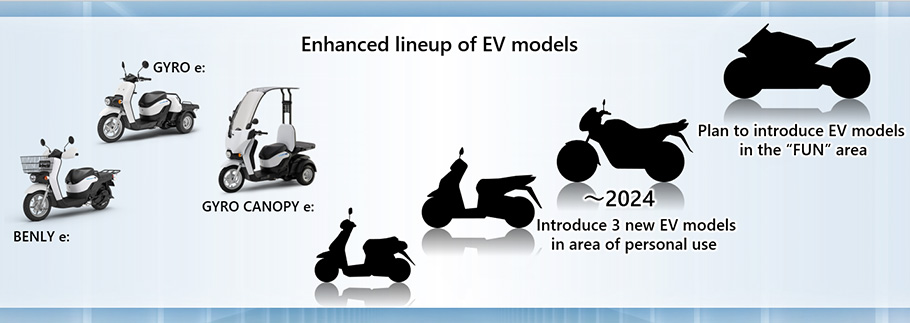
1-4. Fuel cell
Hydrogen is expected to be popularized as a renewable energy source. Honda has a long history of researching, developing and commercializing FC technologies.
While continuing our collaboration with GM, Honda will strive to reduce costs and realize a “hydrogen society” by expanding our lineup of FCVs and also by using FC systems for a wide range of applications, including commercial trucks as well as both stationary and movable power sources.
2. Safety Initiatives
Honda will strive for zero traffic collision fatalities involving Honda motorcycles and automobiles globally by 2050. The major challenge we will face as we work toward this goal is how to eliminate motorcycle collision fatalities, especially in emerging countries. As a company that has both motorcycle and automobile businesses, we will continue to strengthen our research on safety technologies that enable motorcycles and automobiles to safely coexist and lead the way in realizing a collision-free society from the standpoint of both hardware and software.
- Since many motorcycle collision fatalities involve automobiles, we will strive to apply our omnidirectional ADAS (advanced driver-assistance system) to all new automobile models we introduce in developed countries by 2030.
- By leveraging the knowledge and know-how we have amassed through research and development of our Level 3 automated driving technologies, we will further enhance the intelligence of ADAS, which increases the percentage of collision patterns covered by our ADAS.
- Particularly in emerging countries, there are many collisions that can be prevented through traffic safety education activities and by approaching the issue from the perspective of infrastructure and government policies. Therefore, Honda will focus also on such areas including strengthening of educational programs and government/industry relations activities.
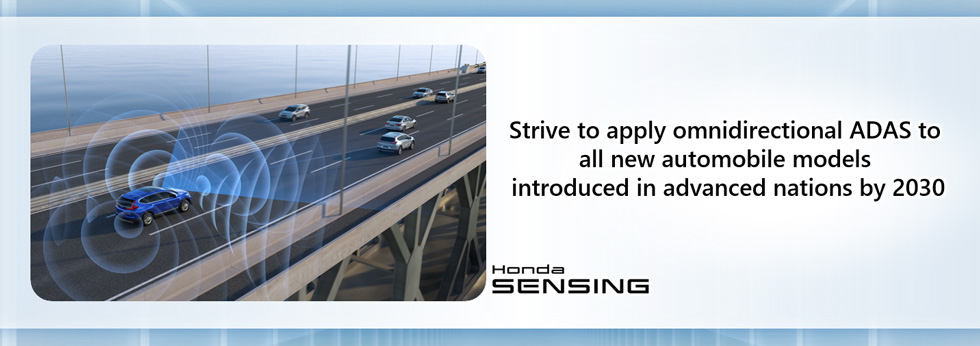
3. Research & Development Initiatives
In order for Honda to keep making progress in its environmental and safety initiatives, it becomes essential for us to invest aggressively in the area of research and development. Therefore, regardless of fluctuations in our sales revenue, Honda will invest a total of approximately 5 trillion yen as R&D expenses over the next six years.
In the field of research and development, including the system and capability for the development of digital technologies which needs to be further strengthened, we will take necessary measures, including alliances, as quickly as possible.
Moreover, we also will take proactive measures to build a strong value chain from the perspective of electrification.
4. Preparations for the future
I believe that the “unique characteristics of Honda” are represented by the “value we derive by thinking through the very essence of things” and our “originality.” Honda is a company with a group of individuals who have the strong desire to be original. We value people's dreams and continue taking on challenges toward ambitious targets. In so doing, we want to be a company that will always pursue the very essence of things and originality.
As of last fiscal year, we enabled Honda R&D to focus on the research of advanced technologies, and we are conducting research on leading-edge environmental and safety technologies for the realization of a society that aims for zero environmental impact and a collision-free society. Also, we are making progress with research on technologies which will expand mobility into the 3rd and 4th dimensions, into the skies, the ocean, outer space and the area of robotics. We will strengthen our original research of technologies by ensuring optimal allocation of resources into the area of advanced and cutting-edge technologies.
Moreover, in order to actively create and deliver new value for our customers, we have started the “New Business Creation Program” where the dreams and ideas of Honda associates become the starting point of each project.
<Closing>
My hope is to hear people saying, “We are glad Honda exists” or “Honda will definitely do it.” Honda wants to continue to be a company that people want to exist. That is what we want to achieve.
To this end, we will establish a business structure which has resilience against changes in our business environment and speedily implement large-scale action plans. We will continue to work aggressively, while always asking ourselves what it means to maintain the unique characteristics of Honda, which is to pursue the very essence of things and to be original.